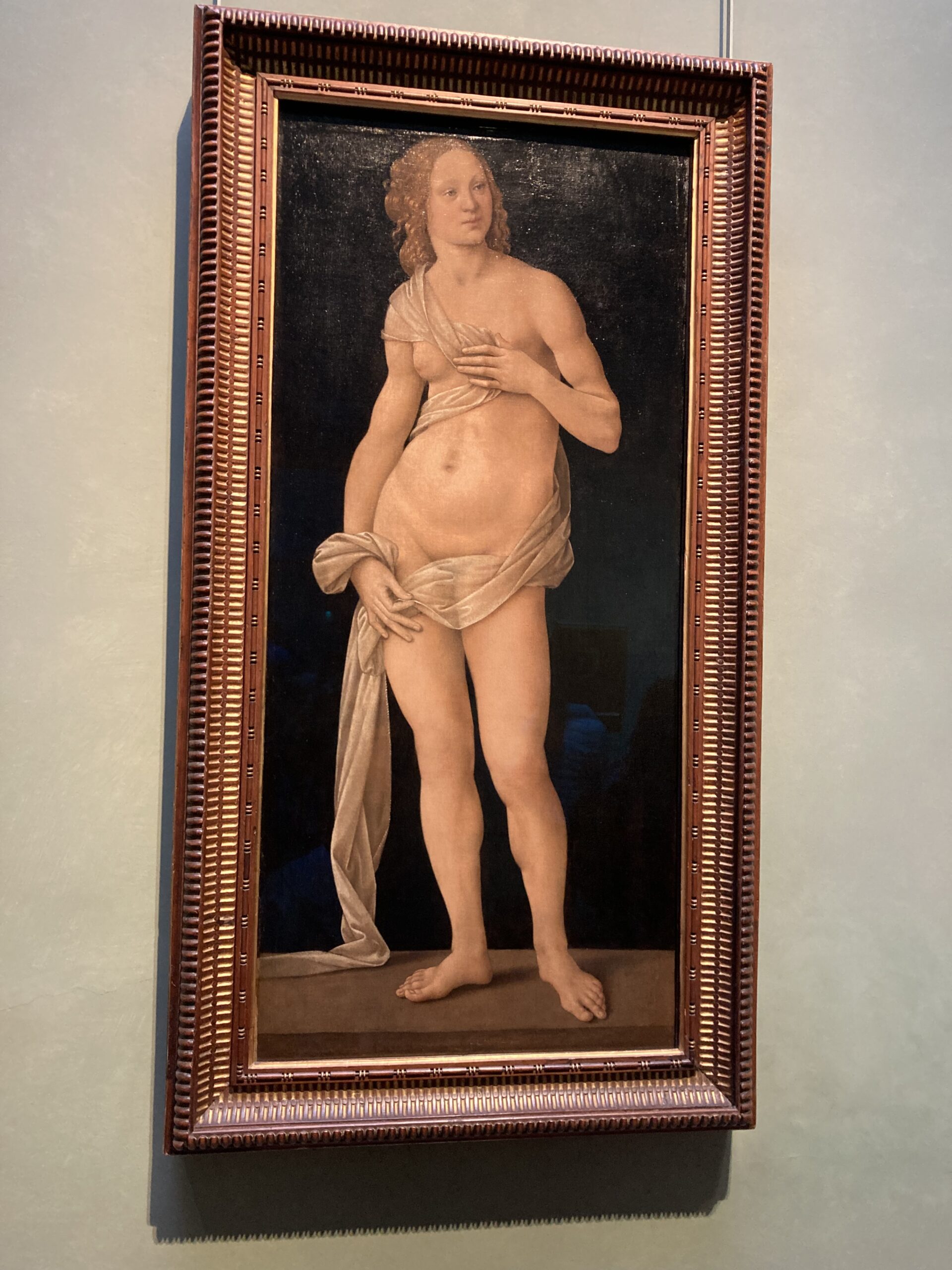
Venus, c. 1490, Oil on Canvas, 151×69 cm, Uffizi Gallery, Florence, Italy
Photo Credit: Amalia Spiliakou, April 2025
In the rich tapestry of Renaissance Florence, few artists garnered the kind of admiration that Lorenzo di Credi did, both in his time and in the eyes of later historians. Giorgio Vasari, in his Lives of the Artists, offers a glowing account of Lorenzo’s early promise and virtuous character, highlighting his transformation from the son of Andrea Sciarpelloni into a renowned artist known simply as “Credi”, a name inherited from his master out of sheer excellence. Vasari’s praise is more than anecdotal; it frames Lorenzo as a model of artistic dedication and moral integrity. In this blog post, we will use Vasari’s vivid narrative as a lens to explore Lorenzo di Credi’s works housed in the Uffizi Gallery, tracing how the values and skills admired by his contemporaries continue to resonate through his paintings today.
To better understand the foundations of Lorenzo di Credi’s reputation, we turn directly to Vasari’s account, where his admiration for the young artist’s talent and character is unmistakably clear: While Master Credi, an excellent goldsmith in his time, was working in Florence with much credit and name, Andrea Sciarpelloni placed with him, so that he might learn that trade, his son Lorenzo, a young man of beautiful intellect and excellent habits. And because as the master was skilled and willing to teach, so the disciple learned with study and speed whatever was shown to him, it was not long before Lorenzo became not only a diligent and good designer, but a goldsmith so polished and skilled that no young man was equal to him in that time, and this with such praise from Credi that from then on Lorenzo was always called, not Lorenzo Sciarpelloni, but Credi by everyone… https://it.wikisource.org/wiki/Le_vite_de%27_pi%C3%B9_eccellenti_pittori,_scultori_e_architettori_(1568)/Lorenzo_di_Credi
Lorenzo di Credi was a Florentine painter and goldsmith whose artistic career flourished during the Italian Renaissance. He began his training in the workshop of Master Credi, the goldsmith, and then Andrea del Verrocchio, where he worked alongside notable contemporaries such as Leonardo da Vinci and Pietro Perugino. Lorenzo’s original apprenticed as a goldsmith translated seamlessly into his painting, earning him high praise from Giorgio Vasari, who admired both his moral character and artistic discipline. Following Verrocchio’s death, Lorenzo took over the workshop, continuing its legacy of refined technique and balanced composition. Though he never achieved the fame of some of his peers, Lorenzo remained a respected figure in Florence for his devout lifestyle and commitment to purity in art.
The artist’s style is characterized by a delicate precision, serene composition, and an emphasis on clarity and harmony. Deeply influenced by Verrocchio’s sculptural forms and Leonardo’s soft modeling, his works often feature idealized figures with calm expressions, set against meticulously rendered landscapes. His use of fine detail and polished surfaces reflects his background as a goldsmith, while his religious subjects convey a deep spiritual devotion. Unlike the dynamic motion seen in later High Renaissance works, Lorenzo’s paintings tend toward stillness and contemplation, embodying a quiet grace that exemplifies the early Renaissance ideals of beauty, order, and restraint.
Lorenzo di Credi’s Venus, painted around 1490–1494 and now housed in the Uffizi Gallery, offers a strikingly different interpretation of the goddess of love compared to the more ethereal versions by his contemporaries. Discovered in 1869 in a storeroom of the Medici Villa at Cafaggiolo, this oil on canvas work is grounded in Classical tradition, evoking the modesty and stance of Praxiteles’ famous sculptures. Yet, its aesthetic departs from Renaissance ideals of graceful femininity: Venus stands firmly, her body rendered with solid, almost masculine anatomical features such as defined biceps, and her feet planted heavily on the ground. Unlike Botticelli’s iconic Venus—floating delicately on a shell in a luminous seascape, Credi’s figure is monumental and statue-like, silhouetted against a dark, undefined background. Even the flowing veil, instead of dancing in the breeze, falls straight down to act as a stabilizing pillar. This Venus, painted before Credi’s turn toward religious austerity under the influence of Savonarola, reflects both his mastery of form and his engagement with antiquity, while its grounded presence challenges the viewer to reconsider conventional ideals of beauty and sensuality in Renaissance art.
For a PowerPoint Presentation on Lorenzo di Credi’s oeuvre, please… Check HERE!
Bibliography: https://www.virtualuffizi.com/lorenzo-di-credi.html and https://www.flickr.com/photos/nikonpaul/33202209738